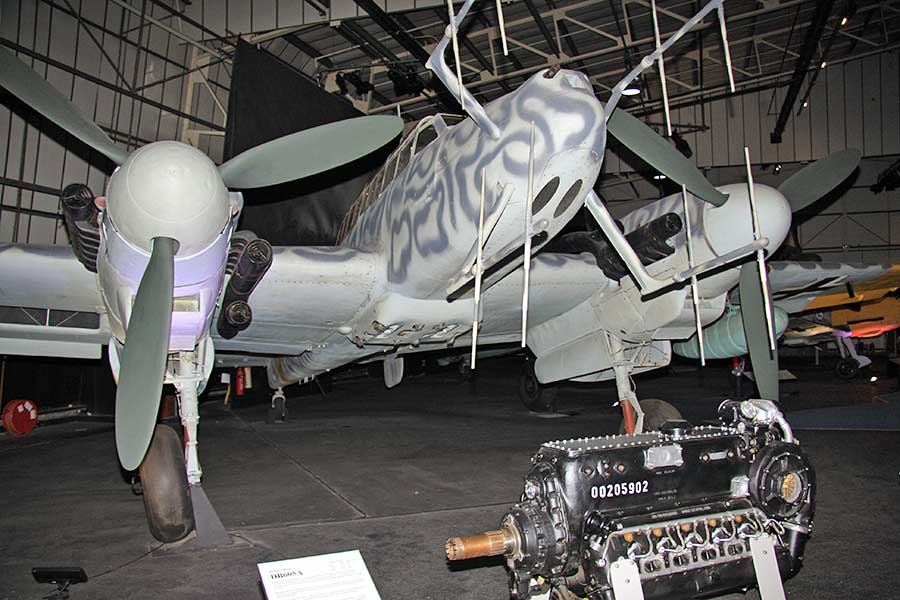



Messerschmitt Bf 110 G4 (730301) [@ RAF Hendon]
The Messerschmitt Bf 110 was designed in response to a 1934 specification for a long-range escort fighter and Zerstorer (destroyer) aircraft. Three prototypes were completed with DB 600 engines, the first of these flying on the12th May 1936. Four pre-series Bf 110 A0s were ordered, powered by 610hp Jume 210B engines, while a small number of Bf 110 B0 trials aircraft were fitted with the 690 hp DB 600A, but these were inadequate and the first production model, the Bf 110 C1, used the more powerful (1100 hp) DB 601A. The aircraft also featured several aerodynamic improvements over the Bf 110 A0, such as square-cut wingtips (which increased speed but had an adverse effect on manoeuvrability) and an improved cockpit canopy. Armament comprised four 7.9 mm (0.31 in) MG17 machine guns and two 20 mm (0.79 in) MGFF cannon, the former in the upper half of the nose and the latter in a detachable tray attached to the fuselage belly. In addition, a manually operated MG15 machine gun was provided in the rear cockpit. First deliveries were made in 1938. The Bf 110 C was also produced in fighter-bomber (C4, C7) and reconnaissance (C5) sub-variants.

Messerschmitt Bf 110 G4 (730301) [@ RAF Hendon]
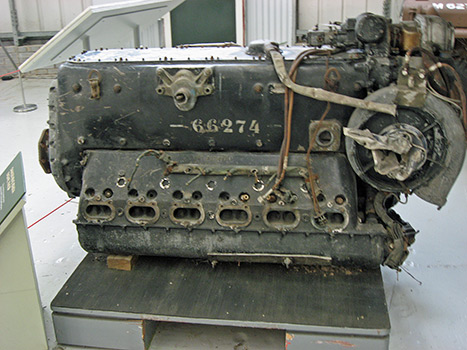 Built sometime during 1944, werknummer 730301, was by the
beginning of 1945 based at Grove, Dänemark, with the “Stammkennzeichen” I/NJG 3
in the night defence of Denmark and Northern Germany. Complete with its FuG 220b
Lichtenstein SN-2 radar it is a heavily armed night-fighter variant. During May
1945 730301 surrendered to the allies at Grove airfield and due to its radar
equipment 730301 was transferred to the Royal Aircraft Establishment at
Farnborough on the 3rd August 1945 for flight testing. Saved from
being scrapped, 730301 spent the post war years stored at various locations
until in 7th August 1978 when after a short restoration at St.Athan
in 1976 730301 was move by road and placed on display at RAF Hendon. This is the
only intact aircraft of this type remaining anywhere in the world.
Built sometime during 1944, werknummer 730301, was by the
beginning of 1945 based at Grove, Dänemark, with the “Stammkennzeichen” I/NJG 3
in the night defence of Denmark and Northern Germany. Complete with its FuG 220b
Lichtenstein SN-2 radar it is a heavily armed night-fighter variant. During May
1945 730301 surrendered to the allies at Grove airfield and due to its radar
equipment 730301 was transferred to the Royal Aircraft Establishment at
Farnborough on the 3rd August 1945 for flight testing. Saved from
being scrapped, 730301 spent the post war years stored at various locations
until in 7th August 1978 when after a short restoration at St.Athan
in 1976 730301 was move by road and placed on display at RAF Hendon. This is the
only intact aircraft of this type remaining anywhere in the world.
Fighting as a day-fighter (Zerstoerer) became more and more difficult. The Bf 110 couldn’t match the performance of the single engined fighters such as the Spitfire or Hurricane. Later on the Allies also introduced twin engined fighters like the P38 Lightning, or even the Mosquito with its superb speed and altitude performance, were vulnerable to Bf 109s and Fw 190s especially when flown by experienced pilots. Despite suffering very serious losses during the Battle of Britain the aircraft continued in quantity production and in 1940 the Messerschmitt factories turned out 1008 Bf 110 fighters and 75 reconnaissance aircraft. The Bf 110 D was originally intended as a long-range escort fighter, and the Bf 110 D0 pre-series aircraft featured a large ventral fuel tank, but the drag this created impaired the aircraft's performance to the extent that it was deleted in the production Bf 110 D1 and replaced by external wing tanks. The D2 could be used in either the fighter or bomber roles and could carry up to two 1000 kg (2205 1b) bombs, and the D3 was a D1 with bomb racks attached. The Bf 110 E1 and E2 were designed as fighter-bombers and were able to carry four 50 kg (110 1b) bombs under the wing in addition to the larger bombs slung under the fuselage, while the E3 was a special long-range reconnaissance model.
On the 10th May 1941 at about 6:00pm Rudolf
Hess, the "Deputy
to the Fuhrer", took off from Augsburg in a Messerschmitt Bf 110 D
(3869) to fly to Scotland. The reasons for doing so remain a mystery but a
number of plausible explanations have been put forward. Equipped with drop tanks
the Me110 avoided being shot down (on Hitler’s orders) and flew at low altitude
and high speed over the North Sea, Northumberland and Scotland. Tracked on
radar two Hurricanes from 245
(Northern Rhodesian) Squadron based at Aldergrove in Northern Ireland were
scrambled to intercept. Over southern Scotland the Czech pilots were
unexpectedly ordered to break off the attack allowing the Me110 to continue the
flight. Shortly after 11pm the Me110 crashed at Bonnyton Moor Farm near
Eaglesham while Hess who had already bailed out landed slightly injured at
Floors Farm. David McLean, a local ploughman, ran out of his cottage at
the rear of Floors Farm and arrested Hess who gave his name as "Alfred Horn".
Shortly afterwards Hess was identified and was eventually transported to P.O.W.
Reception Station, Abergavenny, South Wales where he remained for the duration
of the hostilities. Tried as a war criminal at Nuremburg an International
Military Tribunal found him guilty on two counts of 'concerted plan or
conspiracy' and 'crimes against peace'. He spent the rest of his life
imprisoned in Spandau Prison, Berlin. 3869 was salvaged by 63 MU between the 11th
and 16th May 1941 and was found to be armed with machine guns in the
nose but there was no ammunition on board.
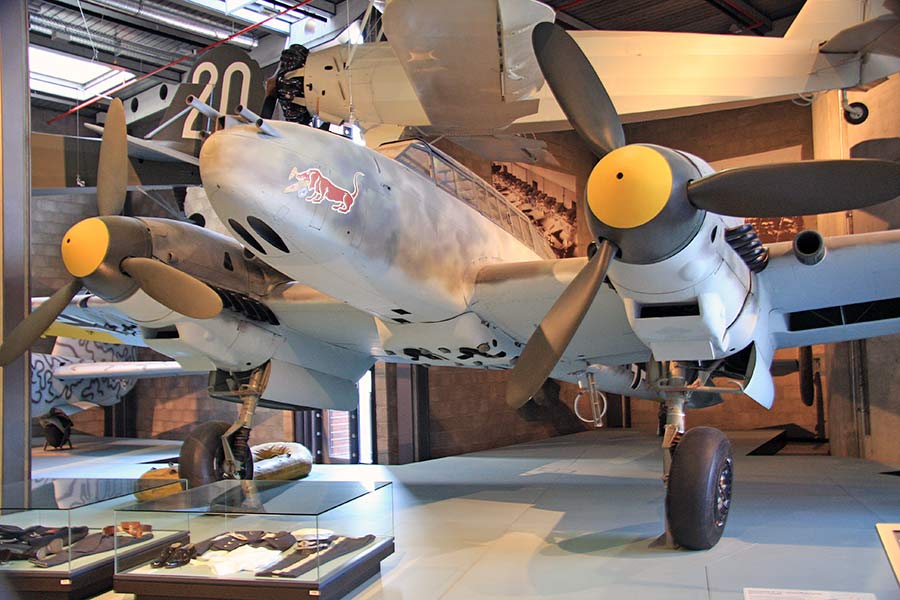

Messerschmitt Bf 110 F2 (5052)
[@ Deutsches Technik Museum, Berlin
The Bf 110 F was similar to the E but with a strengthened airframe and upgraded armour. Designed either as a fighter-bomber (F1), a long-range fighter (F2) or a long-range reconnaissance (F3), it was the F4 that was specifically designed as a 3-crew night-fighter. Earlier variants had 1300 hp DB 601 engines (see photograph above), but the final major production aircraft, the Bf 110 G, produced in larger numbers than any other variant, adopted the 1350 hp DB 605 engine. Produced for all roles, but it was in the night-fighter role of the G2 but mainly the G4 that the Me 110 truly excelled and was responsible for the majority of Bomber Command's night losses due to fighter attack from early 1943. Fitted with additional fuel tanks for a longer endurance, many of the Bf 110 G night-fighters were fitted with the “Schraege Musik”, special machine guns firing at an angle of about 45° to a point above the fighter. This helped the crew to shoot down a bomber when flying parallel to it but underneath it. A flame extinguisher, “Flammenvernichter” was also fitted instead of the normal exhaust system to help to subdue the blue exhaust flames.
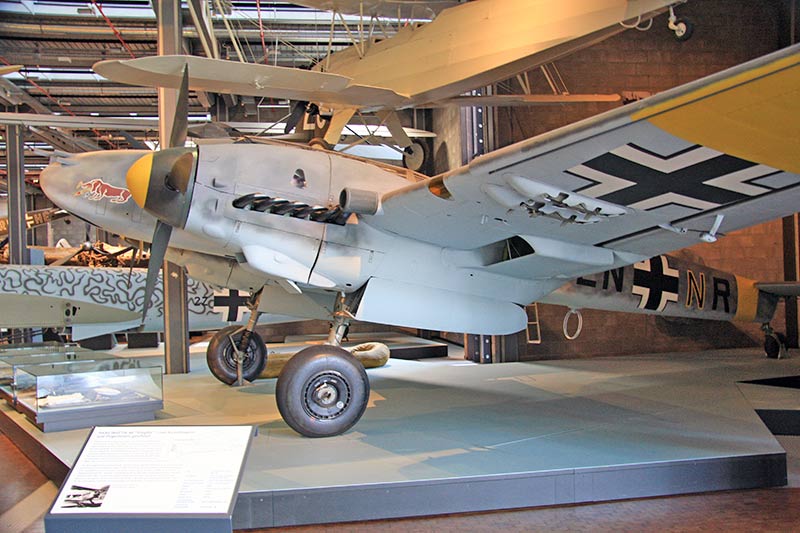
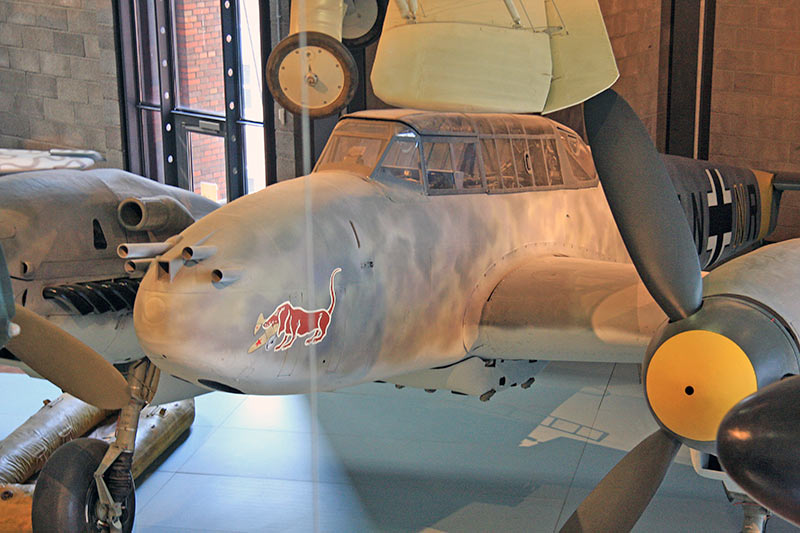
Messerschmitt Bf 110 F2 (5052) [@ Deutsches Technik Museum, Berlin]
5052 flew with the 13 (Z)/JG 55 (Eismeer) based at Kemijarvi
in Northern Finland and was coded LN+NR. On the 11th January
1943 5052 was sent with three other Me 110s to attack the Murmansk-Leningrad
railway line. Forced to do a belly landing on a frozen lake in North
Finland after receiving flak damage due to anti-aircraft guns mounted on a
train. The crew was rescued the next day but 5052 sunk when the ice melted
and remained in the water until salvaged in 1992. 5052 was largely
recovered intact and had suffered only some corrosion around the cockpit.